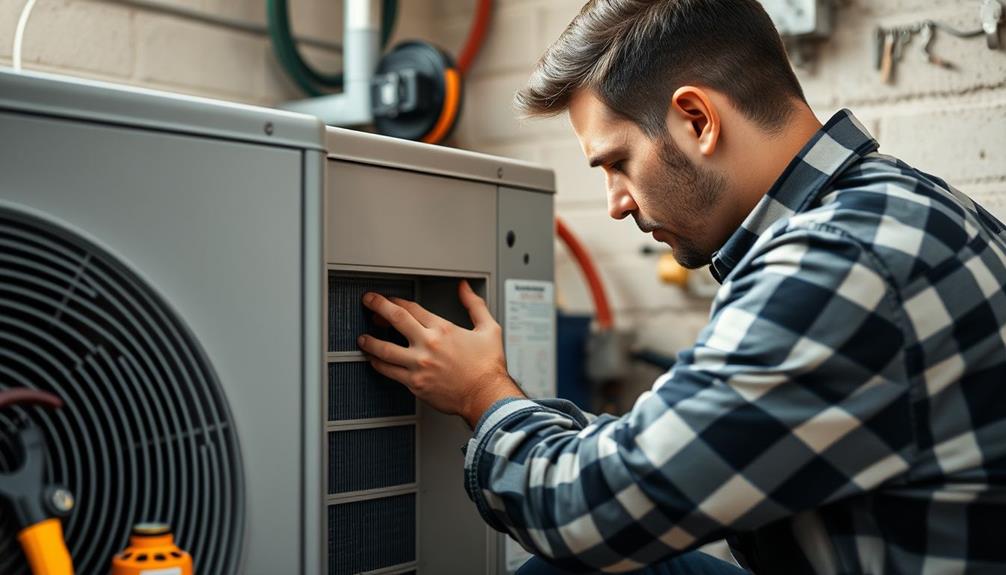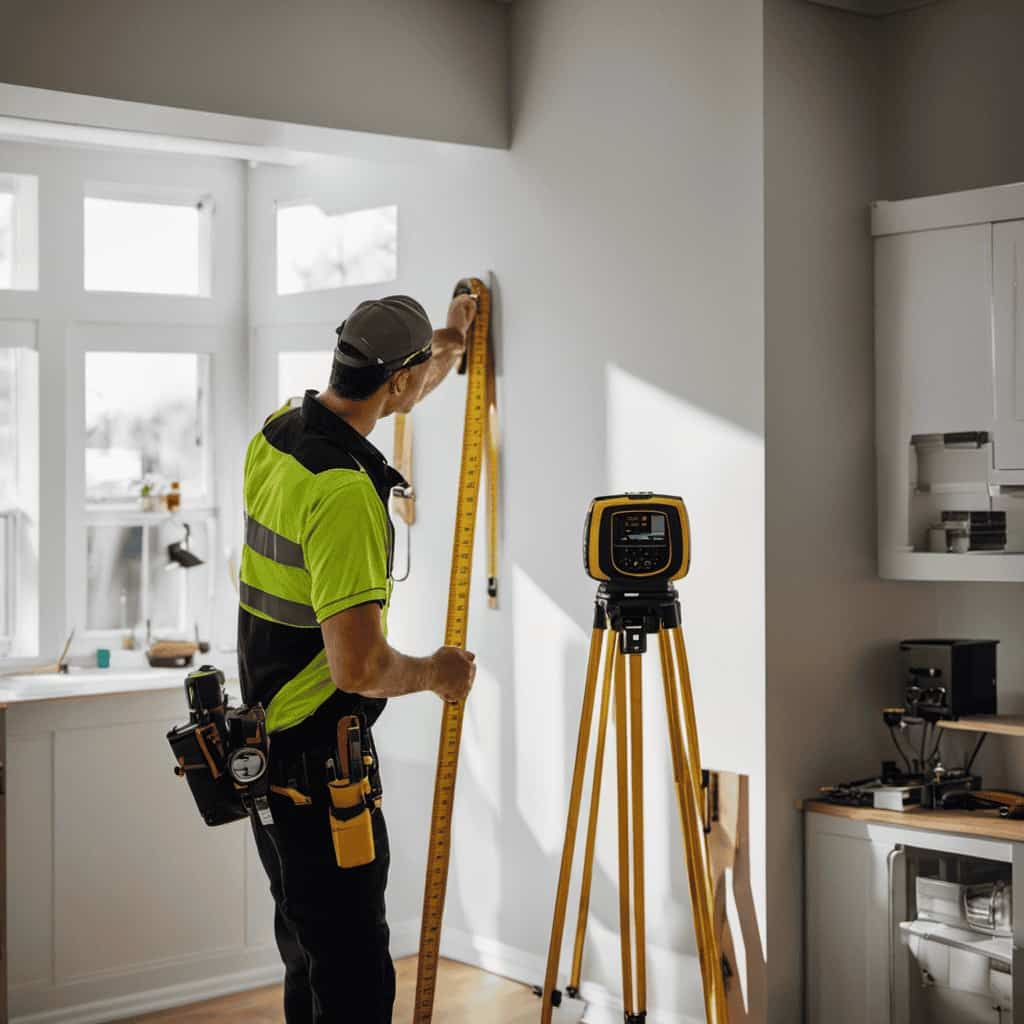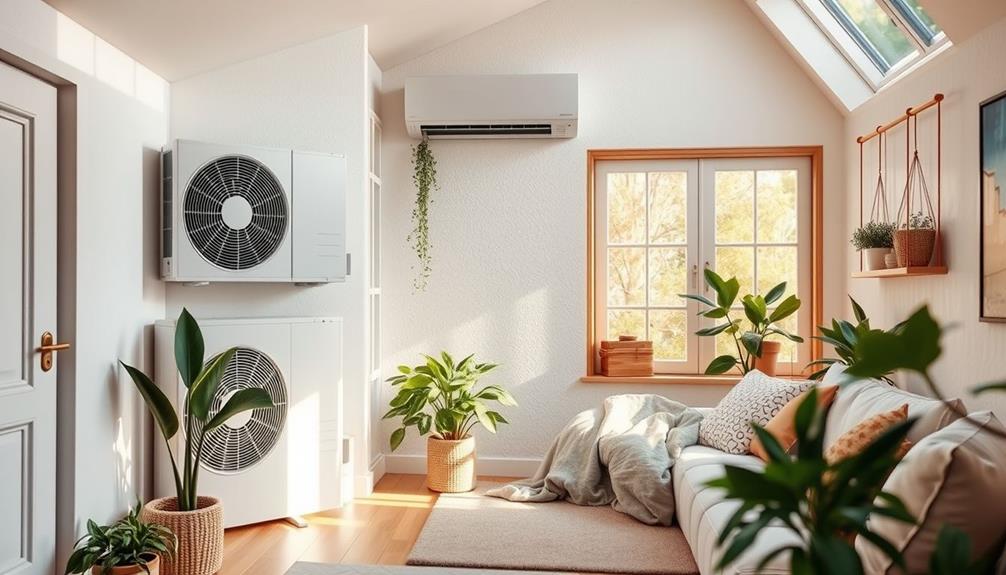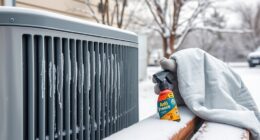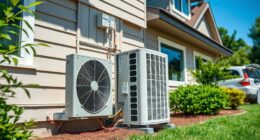Understanding SEER ratings is essential for choosing the right heat pump for your home. SEER, or Seasonal Energy Efficiency Ratio, measures cooling output against energy use. A higher SEER rating means better efficiency, lower energy bills, and improved comfort. In hot climates, aim for a SEER rating of 15 or higher for best performance. While high SEER units may come with a higher initial cost, they often lead to significant long-term savings. Plus, many ENERGY STAR certified models can offer even more benefits. There's a lot more to uncover that can help you make an informed decision for your home.
Key Takeaways
- SEER (Seasonal Energy Efficiency Ratio) measures cooling output in BTUs relative to energy consumed in watt-hours, indicating efficiency levels of heat pumps.
- Higher SEER ratings lead to reduced energy costs and enhance comfort, making them a better long-term investment despite higher initial costs.
- SEER ratings range from a minimum of 13 in northern states to around 28 for high-efficiency models, impacting performance based on climate.
- ENERGY STAR certified units meet strict efficiency guidelines, ensuring significant cooling performance and compliance with energy efficiency regulations.
- Understanding SEER ratings helps homeowners make informed decisions, balancing cost, comfort, and environmental impact in their heat pump selection.
What Is Seer?
When it comes to air conditioning, understanding SEER, or Seasonal Energy Efficiency Ratio, is vital. SEER measures the cooling output of an HVAC system in BTUs divided by the energy consumed in watt-hours over a typical cooling season. This means it helps you determine how efficiently your air conditioning system operates.
Higher efficiency ratings, such as those found in refrigerant heat pumps, can greatly impact your energy consumption.
In the U.S., the minimum federally regulated SEER rating for new units is 13 in northern states and 14 in southern states. However, higher SEER ratings indicate more energy-efficient systems. For example, a unit with a SEER of 21 can save you considerably on electricity costs compared to one with a lower rating.
The SEER rating is calculated under specific test conditions, which means real-world performance may vary based on factors like climate, usage, and system maintenance.
Investing in a higher SEER-rated heat pump not only reduces energy consumption but also leads to substantial long-term savings on your utility bills, as higher efficiency typically results in lower monthly costs.
Understanding these ratings is vital for making informed decisions about your cooling solutions.
Importance of SEER Ratings

Understanding SEER ratings is essential for you as a homeowner since they directly impact your energy costs and environmental footprint.
A higher SEER rating means more efficient cooling, which can lead to significant savings on your utility bills.
Additionally, considering energy-efficient options can contribute to a sustainable living approach that reduces overall energy consumption.
Definition of SEER Ratings
How can you guarantee your home stays comfortable while keeping energy costs in check? Understanding SEER ratings is an essential step. SEER, or Seasonal Energy Efficiency Ratio, measures the cooling efficiency of heat pumps by comparing the total cooling output in BTUs to the total energy consumed in watt-hours during a typical cooling season.
Choosing the right home comfort solutions, such as those with higher SEER ratings, can also greatly enhance your overall efficiency and comfort. When selecting a heat pump, consider options that offer advanced technology and features like quiet operation, which can further improve your home environment.
When you choose a heat pump, a higher SEER rating indicates greater energy efficiency, which translates to lower operational costs and a reduced environmental impact. Newer units usually achieve ratings between 13 and 22, making them a smart investment for your comfort.
For homeowners, opting for a heat pump with a SEER rating of 17 or higher can lead to considerable long-term energy savings, often offsetting the higher initial purchase cost.
The U.S. Department of Energy sets a minimum SEER rating of 13 for northern states and 14 for southern states, with plans to tighten these standards in the future.
Energy Cost Savings
Investing in a heat pump with a higher SEER rating can considerably lower your energy costs while boosting your home's comfort. Higher SEER ratings mean your heat pump operates more efficiently, producing more cooling for each watt of energy consumed. This efficiency translates into significant energy savings, especially during the cooling season.
As homeowners increasingly focus on energy efficiency, understanding the importance of credit card insights can be beneficial when financing such investments.
If you upgrade from a 14 SEER to a 21 SEER unit, you could see annual savings of around $333, which adds up to about $6,660 over the heat pump's lifetime. Since the minimum SEER rating for new heat pumps is 13 in northern states and 14 in southern states, choosing a unit that exceeds these standards is key for ideal savings.
While a higher SEER rating might require a larger initial investment, the long-term cost benefits are undeniable. You'll enjoy reduced operational costs and lower monthly utility bills, making your home more energy efficient.
In a world increasingly focused on sustainability, these energy savings not only benefit your wallet but also contribute positively to the environment. So, make a smart choice and invest in a heat pump with a higher SEER rating today!
Environmental Impact Considerations
A high SEER rating not only boosts your home's energy efficiency but also plays an important role in reducing your environmental impact. By investing in heat pumps with higher SEER ratings, you can greatly lower your carbon footprint.
For instance, a unit with a SEER rating of 22 saves about $333 annually compared to one rated at 13, showcasing both financial and environmental advantages. Additionally, the integration of AI-driven threat intelligence in modern systems can lead to more efficient energy usage, further enhancing your home's sustainability.
When you choose a more efficient system, you contribute to a decrease in greenhouse gas emissions. This aligns with broader sustainability goals aimed at promoting cleaner energy use. As regulatory standards push for higher minimum SEER ratings, adopting these advanced systems becomes increasingly important.
Understanding SEER ratings is vital for you as a homeowner. It directly affects your household's overall environmental impact. By selecting a heat pump with a higher SEER rating, you're not just making a smart financial decision; you're also playing your part in fostering a more sustainable future.
Ultimately, your choice can lead to cleaner air and a healthier planet, emphasizing the importance of energy efficiency in today's world.
Advantages of High SEER

When it comes to choosing a heat pump, opting for a high SEER rating can lead to significant benefits for you as a homeowner. Higher SEER ratings indicate greater energy efficiency in heat pumps, meaning you'll enjoy reduced electricity bills. For instance, a 21 SEER unit could save you around $333 annually compared to a 13 SEER model.
By maintaining a balanced energy approach, you can also improve your stress management techniques regarding utility costs and environmental impact.
While high SEER units often come with higher upfront costs, the long-term energy savings make them a financially sound investment. Over time, these savings can offset the initial expense, allowing you to reap the rewards for years to come.
Additionally, high SEER heat pumps can improve your indoor comfort, especially in humid climates, by maintaining desired temperatures more effectively.
Moreover, many high SEER models qualify for tax credits and manufacturer rebates, enhancing their financial appeal. By choosing a unit with a higher SEER rating, you're also contributing to environmental sustainability.
These units reduce energy consumption, which leads to a smaller carbon footprint and aligns with increasing regulatory standards for energy efficiency.
In short, investing in a high SEER heat pump is a smart choice for both your wallet and the planet.
Comparing SEER Ratings
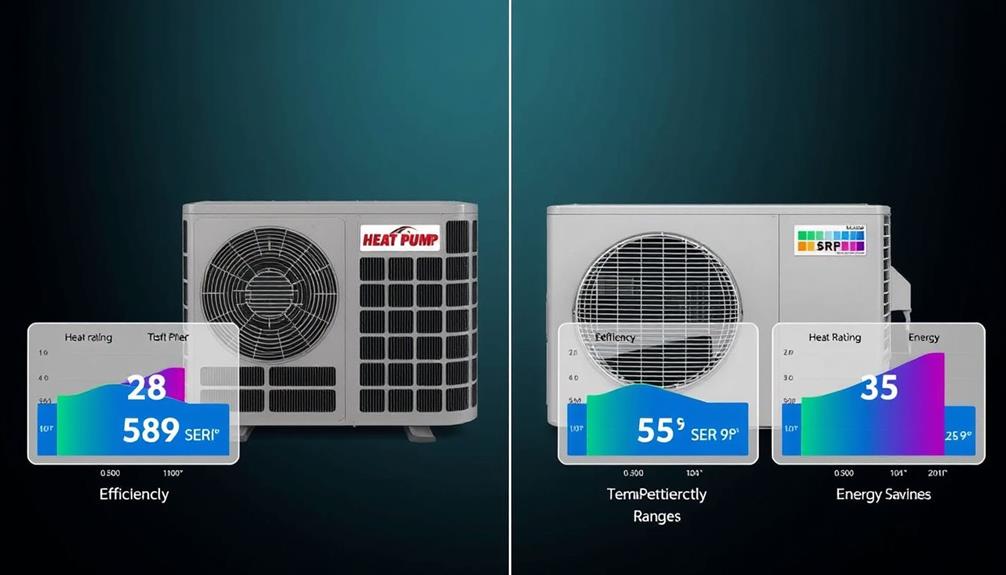
Understanding the differences in SEER ratings helps you make informed decisions about heat pumps. SEER ratings typically range from a legal minimum of 13 to a maximum of around 28. When comparing heat pumps, you'll find that higher SEER units indicate greater energy efficiency, which translates to lower operational costs.
For instance, a heat pump with a SEER rating of 22 can save you about $333 annually compared to one with a SEER of 13. Additionally, just as selecting the right dog breed can impact your lifestyle, unique traits of English Cream Dachshunds can influence your choice of home environment and energy needs.
Higher SEER rated heat pumps often feature advanced technologies, like variable-speed compressors, which optimize cooling output based on your home's demands. While the initial investment in a high SEER rated unit may be higher, the long-term savings on your energy bills can make it worthwhile.
Many homeowners find they recoup this extra cost within just a few years of use. In warmer climates, it's generally recommended to choose a heat pump with a SEER rating above 15 to maximize energy savings and indoor comfort.
When you compare SEER ratings, consider not just the upfront costs, but also the potential for significant savings over time.
SEER and Energy Efficiency

SEER ratings are essential for understanding how efficiently your cooling system operates.
By improving your home's air quality with devices like ozone air purifiers, you can guarantee that your cooling system works more effectively.
A higher SEER not only means better energy efficiency but also translates to lower bills and a smaller carbon footprint.
SEER Explained
For anyone looking to enhance their home's energy efficiency, grasping the concept of Seasonal Energy Efficiency Ratio (SEER) is crucial. SEER ratings measure the cooling efficiency of heat pumps, calculated by dividing the total cooling output in BTUs by the total energy consumed in watt-hours during a cooling season. A higher SEER unit means better energy efficiency, leading to reduced electricity costs.
Here's a quick comparison of SEER ratings:
| SEER Rating | Efficiency Level | Potential Annual Savings |
|---|---|---|
| 13 | Minimum | – |
| 21 | High | $333 |
| 22 | Very High | Up to $333+ |
The current federally mandated minimum SEER rating is 14 for southern states and 13 for northern states, with increases expected in 2023. Investing in a higher SEER heat pump can lead to significant long-term savings. For instance, a unit with a SEER of 22 could save approximately $6,660 over its lifetime compared to a SEER of 13. Always check for ENERGY STAR certified models to guarantee you're getting the best efficiency for your heating and cooling systems.
Importance of High SEER
Investing in a heat pump with a high SEER rating can dramatically impact your home's energy efficiency and your wallet. A higher SEER rating means greater energy efficiency, allowing you to reduce energy consumption for cooling. This is particularly important as energy resources become more strained; for instance, utilizing geothermal energy generation can complement high SEER systems by offering a reliable and eco-friendly power source.
By choosing a heat pump with a SEER rating above 17, you can enjoy significant long-term savings on electricity bills, potentially offsetting any initial purchase costs.
With the current minimum SEER ratings set at 13 in northern states and 14 in southern states, new regulations promoting energy-efficient technology will further elevate these standards. Opting for a unit with a higher SEER rating can lead to annual savings of 20-40% on energy costs compared to older, less efficient models.
Not only do high SEER-rated systems enhance your indoor comfort, but they also contribute to environmental sustainability. By lowering your overall energy usage and reducing greenhouse gas emissions, you're making a positive impact on the planet.
In an age where energy efficiency is paramount, investing in a heat pump with a higher SEER rating is a smart choice that benefits both your home and the environment.
Choosing the Right SEER
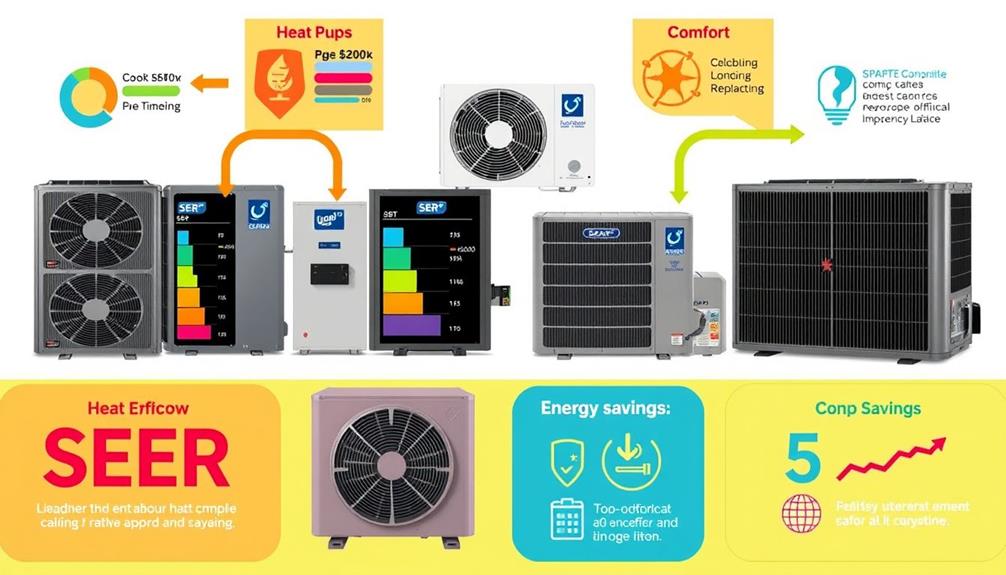
Selecting the right heat pump involves understanding the significance of efficiency ratings. When considering SEER ratings, you should keep a few key factors in mind to guarantee you make an informed decision:
1. Home Climate: If you live in a hotter climate, opt for a heat pump with higher SEER ratings. These ratings indicate better cooling efficiency and can lead to significant energy savings.
Additionally, a well-maintained system can enhance performance and longevity, making it vital to also consider essential home cleaning kit items that can help maintain your unit.
2. Affordability vs. Efficiency: A SEER rating of 14-15 is usually suitable for budget-conscious consumers. However, if you prioritize energy efficiency, look for a rating of 17 or higher.
3. Consult Experts: It's essential to consult with HVAC professionals who can recommend the appropriate SEER rating based on your home's size, insulation quality, and local climate conditions.
SEER Ratings and Cost Savings
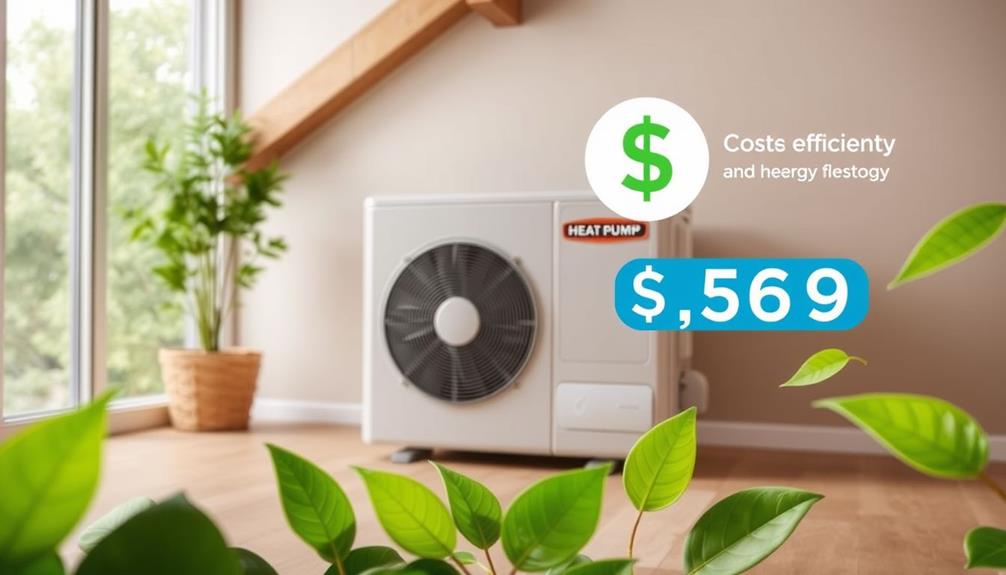
Understanding the connection between SEER ratings and cost savings can greatly impact your wallet. When you invest in a heat pump, higher SEER ratings signify greater energy efficiency.
For example, a unit with a SEER of 21 can save you up to $333 annually compared to one with a SEER of 13. Although the initial cost for high SEER units ranges from $900 to $1,500 more, these upfront expenses are often offset by significant long-term energy savings.
Imagine opting for a heat pump with a SEER rating of 22. Over its lifespan, you could see total savings of around $6,660 compared to a lower-rated model.
These energy-efficient heat pumps result in lower monthly utility bills, thanks to reduced energy consumption for cooling. As energy efficiency standards evolve, choosing a higher SEER heat pump not only guarantees compliance with regulations but also maximizes your cost savings and comfort in the long run.
Ultimately, investing in a heat pump with a high SEER rating is a smart financial decision that pays off over time, helping you keep those energy costs down while enjoying a comfortable home.
SEER in Different Climates

When it comes to choosing a heat pump, climate plays a crucial role in determining the best SEER rating for your needs. In warmer regions, especially in southern states, opting for heat pumps with higher SEER ratings of 16 or above can greatly boost energy efficiency. You'll enjoy lower energy bills and improved comfort during those scorching summers.
Here are some key points to take into account:
- Southern States: These areas have a minimum SEER requirement of 14, but many homeowners choose units rated between 15-18 for ideal cooling.
- Northern States: While the focus on SEER ratings is less, a minimum requirement of 13 still applies. Higher ratings can be beneficial during hot summer months.
- Extreme Heat Areas: If you live in a region that experiences extreme temperatures, investing in a unit with a SEER rating above 17 can result in considerable energy savings and enhanced indoor comfort.
ENERGY STAR and SEER

Choosing a heat pump with the right SEER rating can greatly impact your energy costs, especially in various climates. ENERGY STAR certified heat pumps are your best bet for efficiency and savings. These units meet strict guidelines, requiring a minimum SEER rating of 14 in southern states and 13 in northern states. By selecting an ENERGY STAR heat pump, you can enjoy significant benefits in both cooling efficiency and heating performance.
| Feature | Benefit |
|---|---|
| SEER Ratings | Higher efficiency, lower energy costs |
| ENERGY STAR Certified | Independently tested for reliability |
| Potential Savings | Save 20-40% on energy bills |
These advanced heat pumps utilize cutting-edge technology to optimize both cooling and heating, promoting overall energy savings. When you choose an ENERGY STAR certified model, you're not only investing in your comfort but also contributing to reduced emissions and lower energy bills. By focusing on high SEER ratings, you're ensuring that your heat pump operates efficiently, making a positive impact on your wallet and the environment.
Future of SEER Ratings
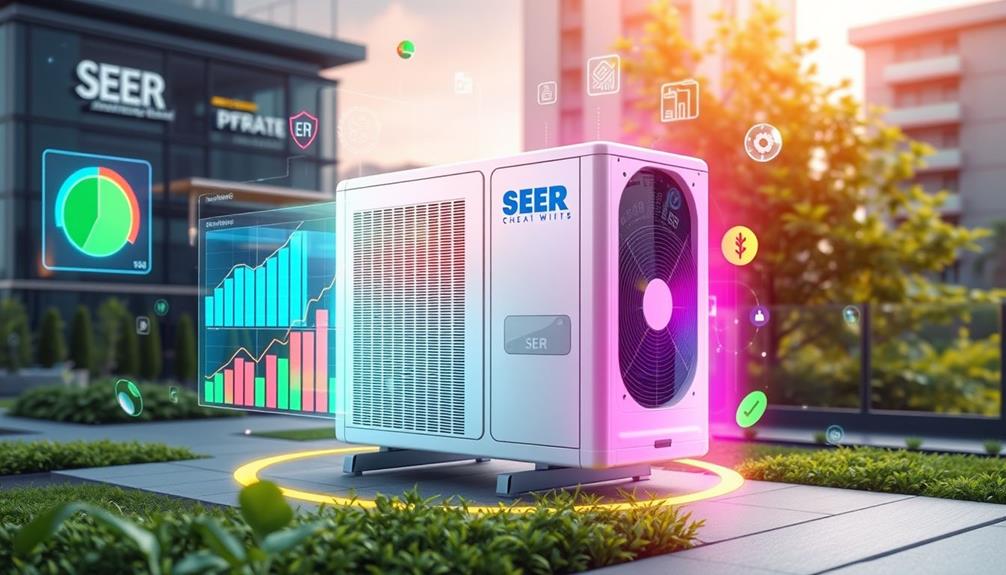
The future of SEER ratings promises a significant shift toward enhanced energy efficiency and sustainability. As regulatory standards evolve, you can expect a greater emphasis on higher SEER ratings in HVAC systems. Starting in 2023, minimum SEER ratings will increase to 14 in northern states and 15 in southern states, reflecting a national commitment to energy efficiency.
Here are three key trends shaping the future of SEER ratings:
- Innovative Technology: Manufacturers are developing units that could achieve SEER ratings above 30, pushing the envelope on efficiency.
- Consumer Awareness: With rising energy costs and environmental concerns, you're likely to see increased demand for higher SEER-rated units, influencing market prices.
- Smart Home Integration: Smart home technology will play a vital role in optimizing energy consumption, allowing you to monitor and adjust your HVAC systems in real time.
As these trends continue, you'll find that investing in HVAC systems with higher SEER ratings not only reduces your carbon footprint but also leads to long-term savings on energy bills.
Embracing these changes will benefit both your wallet and the planet.
Frequently Asked Questions
What Is a Good SEER Rating for a Heat Pump?
A good SEER rating for a heat pump typically falls between 15 and 20. Higher ratings mean better energy efficiency and lower costs, so you should aim for at least 18 for ideal savings and performance.
Is It Worth Going From 14 SEER to 16 Seer?
You might think the cost difference isn't worth it, but upgrading to a 16 SEER can save you $200 to $300 annually. Those savings quickly add up, making the investment worthwhile in the long run.
Is Higher SEER Worth the Money?
You'll find that a higher SEER rating can save you money on energy bills over time. While the upfront cost is more, the long-term savings often make it worth the investment for efficiency-focused homeowners.
What SEER Rating Do I Need for Tax Credit 2024?
To qualify for the 2024 tax credit, you need a heat pump with a minimum SEER rating of 15. Higher ratings may reveal more savings, with some states offering additional incentives for SEER ratings above 16.
Conclusion
To summarize, understanding SEER ratings can greatly impact your comfort and savings. Did you know that a heat pump with a SEER rating of 20 can be up to 60% more efficient than one with a rating of 10? By choosing a higher SEER-rated system, you're not just investing in better energy efficiency; you're also setting yourself up for long-term cost savings and a more sustainable future. So, when upgrading, keep SEER ratings at the forefront of your decision!

